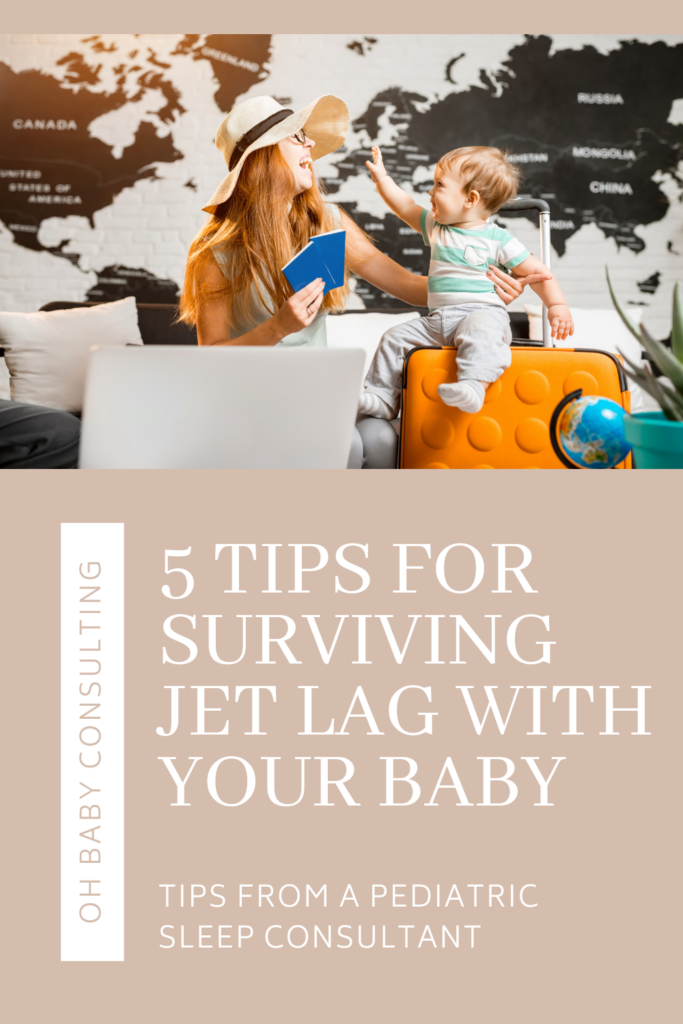So, you’re traveling. Across multiple time zones. With a baby.
Before you venture out, I want to make sure you’re armed with all the information you need keep sleep on track so everyone can enjoy their time away. So how do you maintain good sleep habits while on vacation? And if you’re crossing time zones (a tough feat for any traveler) how do you deal with the inevitable jet lag that comes along with it?
Here are my top tips:
1. Avoid the Red Eye (When Possible)
It’s nice to envision a scenario where we jump on the plane when your child is already asleep and they just magically stay sleeping through the entire flight arriving fresh and rested in a new land. While there certainly may be some babies who can adapt to this dream scenario, the odds are overwhelmingly against us. It’s much more likely that you’re both going to have an awful night and arrive at your destination frazzled and extremely overtired. If you’re traveling domestically and have the option to fly during the day, opt for a daytime flight and hope for a decent nap or two along the way. Since you’re going to arrive with some accumulated sleep debt anyway, it’s better to have this motion-induced sleep disrupt daytime naps rather than travel during periods of more restorative nighttime sleep.
If you’re traveling internationally, many flights abroad happen overnight. In this situation, a red-eye is unavoidable so bring along as many nighttime sleep cues as possible to help your child get some sleep on the plane. Sleep sacks, portable sound machines, books, loveys – whatever you need to cue your child’s body and brain that it’s time for sleep even in an unfamiliar place.
2. Get on Local Time (Or Not…)
If you’re only traveling for one or two nights, it’s probably not worth making major adjustments to your child’s bedtime regardless of the time difference. Experts say that on average, jet lag lasts for one day per hour of time change, so you’ll have to weigh whether it’s worth it for your child to finally get acclimated to a new time zone only to immediately turn around and have to do it all over again upon return home. If you’re traveling domestically from West to East, this may actually work in your favor and you can keep your little one up later with minimal issues.
If, however, you are going to be gone for longer than a couple days or are jumping across several time zones (i.e. traveling abroad) then you’ll want to adjust to the new time zone as quickly as possible. Luckily, our bodies have an inherent ability to adapt to new time zones based on the light/dark cycle, so you’ll have that working in your favor. On that note…
3. Use Light to Your Advantage
As much as we don’t want any shred of sunlight getting into the room while your child is trying to sleep, we do want to expose them to it fully when they are awake. Getting a significant amount of sunlight during the day fires up melatonin production and will help your child’s circadian rhythm more quickly adjust to local time. Getting outdoors and into the sunlight during the day will work wonders in helping your child (and you!) sleep well overnight. Start by getting outside first thing in the morning on your first morning there and then make sure you have opportunities for sun exposure throughout the rest of the day too.
On the flip side, you’ll want to block out any external light sources for sleep. Especially when traveling abroad, this can be extremely helpful in shifting the body clock. To make bedtime a bit easier, you can also dim any internal lights at least two hours prior to your child’s bedtime.
When deciding how to darken your child’s sleep environment, there are a few options:
- Bring along portable blackout shades like these.
- Stash a few black garbage bags in your suitcase. Don’t forget some painters tape to safely tack them to the windows!
- My favorite option is to bring a SlumberPod, which helps make any room not only completely dark but also will give your child their own private space if you need to room-share. (Use code ohbabyconsulting for a discount!)
4. Add an Extra Nap When You Arrive
Even in the best-case scenario, your child is still going to be beat after a full day of travel. An extra nap (even one that’s just 25 minutes) can really help counteract the overtiredness that comes after a long flight. Just be conscious of leaving enough time between when they wake and bedtime for their sleep pressure to rise again.
5. Stick to Your Bedtime Routine
Bedtime routines are about more than just getting into our pajamas, brushing our teeth, and washing our face. A predictable bedtime routine sends signals to the brain that sleep is on the horizon which allows the brain to fire up melatonin production and slow down mental activity, and for the body to relax its muscles. Whatever your baby’s bedtime routine is at home, stick to is as closely as possible when you’re away.
Nobody thrives when they’re sleep deprived and children are no different. We all get a little bit (or a lotta bit) grumpy and short-tempered after a long day of travel. Travel – especially international travel – is going to require a great deal of patience and a lot of consistency to minimize the effects on your baby.
If your goal is to travel the world and sleep well doing it, grab a copy of my Travel Guide and start planning your next adventure!
[I independently source and vet any products that I choose to share on my site. If you buy from the links I’ve provided, I may receive a small commission, which in turn supports my work.]














